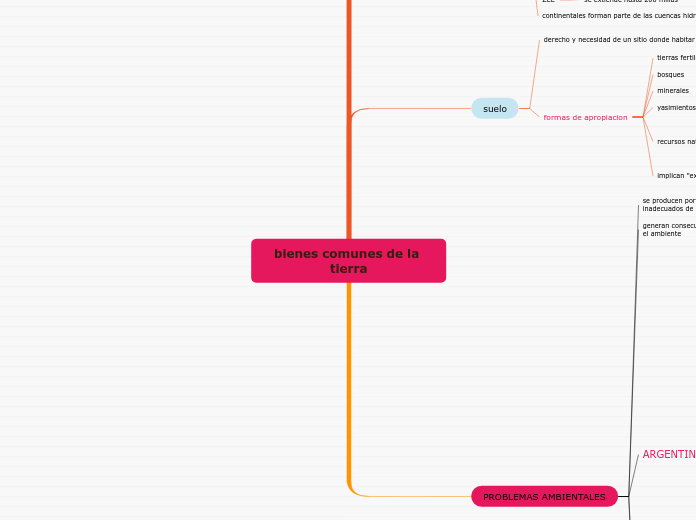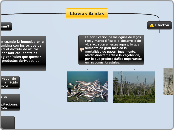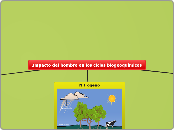bienes comunes de la tierra
To name your story, you have to think about the overall message and what you want your audience to understand from the story. Also, make it relevant and easy to remember.
PROBLEMAS AMBIENTALES
CALENTAMIENTO GLOBAL
sus consecuencias
aumento o disminucion de los caudales hidricos
disminucion de nasas de hielo polar
para reducir
la adaptacion
mitigacion
afecta a la superficie en su totalidad
cambio climatico global
se produce sequias, olas de calor, frios intensos, aumento de presipitaciones
CONTAMINACION DE FUENTES NATURALES DE AGUA
son desperdicios cloacales producidos en domicilios
ARGENTINA
SUSTENTABILIDAD EN ACCION
VIVIENDAS ECOLOGICAS
techos y terrazas verdes
consiste en cubrir con vejetacion los techos, terrazas y edificios
escovillas
cultivan alimentos, cultivan energia por aerogeneradores y se lleva adelante un plan de reforestacion
reservas nat. urbanas
ayudan a generar conciencia ambiental
algunas construcciones se diseñan para poder aprovechar la calefaccion y la refrigeracion
ENERGIAS ALTERNATIVAS
E. EOLICA
eficaz para bombeo de agua y generacion de electricidad
generado por la fuerza del viento
E. SOLAR
requiere energia proveniente del sol
segura e ilimitada
MINERIA A CIELO ABIERTO
sus problemas ambientales
modificaciones en los ecosistemas y el paisaje
contaminacion del aire
generacion de toneladas de residuos o escombreras
eliminacion de vejetacion nativa- deforestacion
alto consumo del agua y la energia
contaminacion del agua y los suelos
esto afecto aplias zonas
las extracciones se llevan a cabo mediante voladuras o explosiones
DESTRUCCION DE BOSQUES NATIVOS
elimino bosque chaqueño y reduzco los principales ambientes de la selva
disminusion de lugares de recreacion y turismo
perdida de la biodiversidad
liberacion del del dioxido de carbono de carbono de los arboles
deterioro de los suelos
la tala de estos es una practica
generan consecuencias negativas en las sociedades y el ambiente
se producen por modos de apopiacion y usos inadecuados de los recursos
suelo
The ending of a story is essential. We all know that if the ending is weak, what happened before loses its importance. So make it unpredictable, but fair. A resolved ending answers all the questions and ties up any loose threads from the plot.
formas de apropiacion
This is the closure section of the story.
See examples of possible outcomes below:
- all problems have been solved
- it's clear how each one of your characters ends up
- your main character is transformed by the challenge
implican "extranjerizacion de los recursos"
recursos naturales
del estado nacional
provinciales
son propiedad privada
yasimientos de hidrocarburos
minerales
Try answering these questions in order for you to come up with a closure:
- Have all problems been solved?
- Is it clear what happens with all your characters in the story?
- Has the challenged transformed your main character?
- How do the characters feel in the end?
bosques
tierras fertiles
Try answering these questions to come up with a closure:
- Have all the problems been solved?
- Is there a clear picture of what happens with each character in the story?
- Has the challenge transformed your main character?
- How do the characters feel in the end?
derecho y necesidad de un sitio donde habitar
This is the moment when the main character surpasses the last obstacle and finally faces their greatest challenge.
The climax usually follows one of these patterns:
- realization
- resolution
- choice
Type in your answer.
agua
The middle of the story is where you add layers of complications that will lead to the end. Reveal more about the character's journey. Did their personality go through changes? How did they overcome the challenges? And as you build up the story’s central conflict, make it more personal to that character. Also, from the middle act, you have to lead into the final act.
continentales forman parte de las cuencas hidricas
ZEE
se extiende hasta 200 millas
argentina forma parte de un sector adyacente
mar territorial
su distribucion en el planeta no es homogenea
There wouldn't be any tension and excitement in your story if there weren't any obstacles in your character's way.
What prevents your character from accomplishing their goal?
A story is nothing more than a character overcoming a series of difficulties to reach the desired goal. Obstacles usually create suspense and conflict. In overcoming obstacles, there is growth: weak becomes strong; hatred turns into love; sadness into happiness; wrong into right; lies into truth; or evil becomes good.
See a few examples below:
- stopping a meteor
- finding a killer
- finding love
Obstacles
derecho humano universal
Your character(s) need(s) motivation in order to solve the challenge(s).
se obtiene de rios y aguas subterraneas
Each story has a main character and that character usually needs to solve a problem or challenge. The character's challenge is the one that creates tension throughout the story.
Other Challenges
Type in any other challenges which other characters in the story need to face.
Other challenges
What are the main challenges in your story?
In most stories, there are 3 challenges. The number 3 is a mystical number symbolizing completeness. Try to come up with interesting challenges with which your character needs to struggle.
See a few examples below:
- turns into a werewolf at night
- is sent back in time
Challenges
aire
In the beginning of the story (or the exposition), you will need to introduce the setting and characters. You might also want to introduce the main conflict. This part of the story is important because it gives the reader necessary background information and maybe even a first insight into a character’s personality.
contaminacion
gases
dioxido de carbono
atentan contra el bien comun
provoca problematicas locales, regionales y mundiales
atmosfera
The setting (time & place) of a story can change throughout the plot.
medio para la circulacion de transporte aero
contiene oxigeno que respiramos
The time of the story can also change. It can describe the event of a single day or can include an entire year's plot. Anyway, don't forget to mention it.
provee recursos importantes para la vida de las personas
Your story can take place wherever your imagination will take you to.
For example: in an elevator, in an enchanted forest, etc. Don't forget to give details of the environment each time the setting changes, otherwise, the story can be confusing. Also, mention the seasons as each of them has unique weather and events.
capa gaseosa que envuelve a la tierra
Characters are essential to a good story. Usually, the protagonist(s) is/are the most affected by the plot. Introduce a character by focusing on their actions, interests, and occupation, as the physical appearance doesn't make a difference in most cases.










